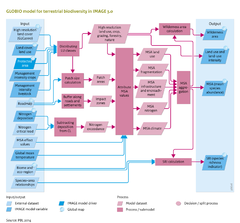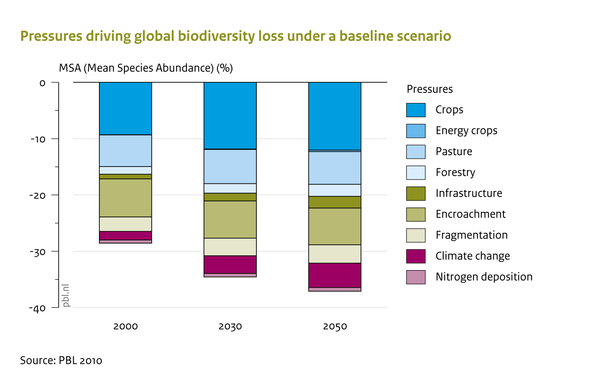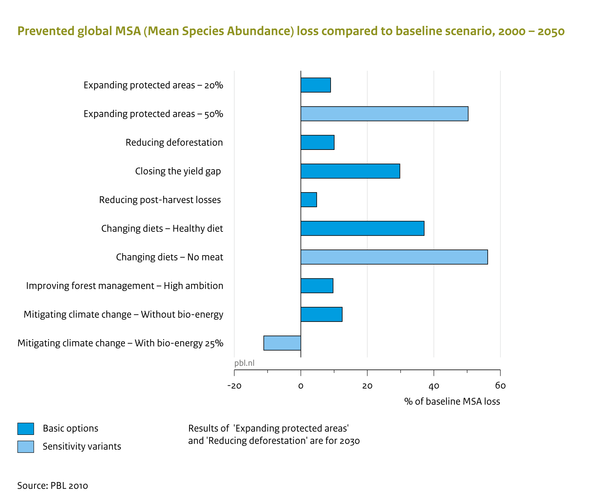Terrestrial biodiversity/Policy issues
Parts of Terrestrial biodiversity/Policy issues
| Component is implemented in: |
|
| Projects/Applications |
| Key publications |
| References |
Baseline developments
The GLOBIO model is used regularly to evaluate biodiversity impacts under baseline scenarios. Although the biodiversity decline depends on scenario assumptions, these studies all project decline in coming decades at a similar rate as in the previous decades. The main drivers of biodiversity loss are land-use change, infrastructure expansion and, increasingly, climate change (the figure below).
Policy interventions
Biodiversity loss is caused by a wide range of activities in various sectors, and policy interventions in major sectors could prevent or reduce biodiversity loss. The most often suggested option is protection of specific nature areas (reserves) to prevent further habitat loss for selected ecosystems. In addition, land pressure could be reduced, for example, by intensification of production, a shift in the human diet to fewer animal products, and waste reduction. The impact of climate change on biodiversity reduces with effective mitigation policies in place. Increase in sustainable forests may also reduce biodiversity loss in the long term.
The Rethinking Biodiversity Strategies study (PBL, 2010) evaluated a series of options (the figure below) and shows that several options need to be introduced to significantly reduce biodiversity loss. Several interactions were found between these options. In some cases, the combined effect is smaller than if measures are taken individually. In other cases, synergistic effects were noted, for example, creating nature reserves may lead to higher crop prices, and in combination with yield improvements may prevent biodiversity loss without negative impact on crop prices. Analyses in Rethinking Biodiversity Strategies (PBL, 2010) and Rio+20 (PBL, 2012) also show that, up to 2030, further biodiversity loss cannot be prevented completely, but can be halted after 2030 with ambitious policy action.
Effects of policy interventions on this component
| Policy intervention | Description | Effect |
|---|---|---|
| Agricultural trade policies | Changes in agricultural trade policies are applied to the corresponding quota (export or import quota) or border taxes. (Reference:: Verburg et al., 2009) | |
| Change in grazing intensity | Change in grazing intensity, usually more intensive. This would require better management of grasslands, including for example the use of grass-clover mixtures and fertilisers, bringing the length of the grazing season in tune with the period of grass production, and rotations. | Effects biodiversity in two ways: less grazing areas decrease the impact on habitats, while more intensive management or increased grazing intensity icnreases the pressures on biodiversity of the remaining areas. |
| Changes in consumption and diet preferences | Interventions that target consumption changes or changes in dietary preferences (Reference:: Stehfest et al., 2013) | This intervention reduces the pressure from agricultural land use to terrestrial biodiversity. |
| Changes in crop and livestock production systems | General changes in crop and livestock production systems, e.g. more efficient production methods to create higher production per unit of input, or other systems like organic farming | Impacts terrestrial biodiversity in two ways: 1) a smaller agricultural area decrease habitat loss and 2) it increase intensity of the agricultural area and consequently the biodiversity value of those areas. |
| Closing the yield gap | This intervention increases actual yields (reduces the gap between potential and actual yields), usually realized by better management. | Decreases the pressure on land for agriculture. On the other hand it can increase the pressure from emissions towards natural areas. |
| Enlarge protected areas | Increase in areas with protected status, as well the size of the areas as the numer of parks. (Reference:: PBL, 2010) | No pressure from agricultural land use in protected areas. Outside protected areas this pressure may increase. |
| Expanding Reduced Impact Logging | Increasing the share of produced wood yielded with Reduced Impact Logging (RIL) practices instead of conventional logging practices. (Reference:: PBL, 2010) | The impacts on biodiversity is lower using RIL practices instead of the conventional practices. This because (i) less forets will be used (higher biodiversity on large scale); (ii) a better and faster regrowth of the harvested forests, also thus a long-term increasing biodiversity also within these forests. |
| Implementation of biofuel targets | Policies to enhance the use of biofuels, especially in the transport sector. In the Agricultural economy component only 'first generation' crops are taken into account. The policy is implemented as a budget-neutral policy from government perspective, e.g. a subsidy is implemented to achieve a certain share of biofuels in fuel production and an end-user tax is applied to counterfinance the implemented subsidy. (Reference:: Banse et al., 2008) | Targets for biofuel production/blending impact terrestrial biodiversity in two ways. Firstly, land used for biofuel crops usually has a negative impact on biodiversity. Secondly, mitigated climate change - due to the use of biofuels - probably has a positive impact on future biodiversity (change). |
| Implementation of sustainability criteria in bio-energy production | Sustainability criteria that could become binding for dedicated bio-energy production, such as the restrictive use of water-scarce or degraded areas. | Sustainability criteria limit the use of land for bio-energy cultivation and therefore reduce pressures on biodiversity from climate policies (via bio-energy production). |
| Increase forest plantations | Increase the use of wood from highly productive wood plantations instead of wood from (semi-) natural forests. (Reference:: PBL, 2010) | Terrestrial biodiversity is effected in two ways: 1) the area with forestry impacts will be smaller, and 2) the biodiversity value of plantations will be lower than (semi-)natural forests in which logging takes place. |
| Reduction of waste/losses | Reduction of losses in the agro-food chain and waste after consumption. (Reference:: PBL, 2010, PBL, 2012) | The reduced need for agricultural area decreases habitat loss or could even result in an increased natural area. |


